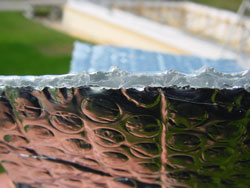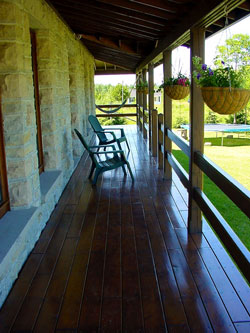It’s easy to keep cool during the hottest summer weather with a big air conditioner and lots of electricity. Anyone can do that. The trick is cooling your home while also being environmentally and financially responsible. Here are five uncommon strategies that will help keep your home cool with minimal resources.
Radiant Barrier Foil
 This stuff looks like shiny bubble wrap and reflects heat upwards and away before it ever hits your attic insulation. Although relatively simple, it’s an often overlooked option for cooling houses built with typical, insulated attics. Offered by a handful of different companies, radiant barrier foil doesn’t have any insulation value in itself, but simply reflects radiant heat energy. Think of how much cooler it is under the shade of an umbrella on a sunny day at the beach and you’ll get a sense of how radiant barrier foil works. Although the umbrella has no significant R value, it still makes you feel a lot cooler while you’re under it. The shiny, aluminum-based material used to make radiant barrier foil reflects energy especially well in the wavelengths common in a super-heated attic during summer. What’s more, installation of radiant barrier foil is easy. Simply spread out a single layer over your existing attic insulation. If your attic has less than R40 or R50 of conventional insulation in place right now, add more before installing radiant barrier foil. Also, make sure the kind of barrier foil you use is perforated with small holes to allow moisture to escape.
This stuff looks like shiny bubble wrap and reflects heat upwards and away before it ever hits your attic insulation. Although relatively simple, it’s an often overlooked option for cooling houses built with typical, insulated attics. Offered by a handful of different companies, radiant barrier foil doesn’t have any insulation value in itself, but simply reflects radiant heat energy. Think of how much cooler it is under the shade of an umbrella on a sunny day at the beach and you’ll get a sense of how radiant barrier foil works. Although the umbrella has no significant R value, it still makes you feel a lot cooler while you’re under it. The shiny, aluminum-based material used to make radiant barrier foil reflects energy especially well in the wavelengths common in a super-heated attic during summer. What’s more, installation of radiant barrier foil is easy. Simply spread out a single layer over your existing attic insulation. If your attic has less than R40 or R50 of conventional insulation in place right now, add more before installing radiant barrier foil. Also, make sure the kind of barrier foil you use is perforated with small holes to allow moisture to escape.
Openable Skylights
Even with all windows open, most Canadian homes still trap a lot of unnecessary summertime heat around ceilings – especially in the upper levels of two or three storey homes. Warm air demands to rise, and that’s why openable skylights offer such enormous relief during summer heat waves. By letting air rise up and out of the highest parts of your home, air is free to flow in through windows and up through all floor levels. I know from experience at my own place that the effect is amazing. The day I cut through the roof at my house and installed four openable skylights in a third-floor attic loft was the day we cut our already-minimal air conditioner use in half. With the skylights open along with windows in the lower levels, there’s a constant upward movement of air that never happened before. And besides fresh breezes, openable skylights foster a bright, delightful atmosphere in any room.
Managing Basement Humidity
Hot, summer weather causes damaging levels of basement humidity to develop, and this situation is rarely managed properly because the technical details are commonly misunderstood. The problem begins when outdoor air develops high relative humidity levels. As this air enters your basement through windows or vents, it cools, reducing the amount of moisture the air can hold, often driving relative humidity levels up to the point of condensation. This normally happens near basement floors, often hidden from view within carpet fibres that soon smell musty. Since the source of the moisture is the outdoor air itself, ventilation during hot weather is definitely not what you want. Instead, keep all basement windows closed during hot, humid weather, using a dehumidifier when relative humidity levels rise above 70%. Open basement windows and shut off the dehumidifier when the air gets cooler and drier. Keep an eye on your humidity meter as you get a feel for the right conditions for opening and closing basement windows.
Attic Ventilation
 Even with central air conditioning, it’s not unusual for the upper floors of Canadian homes to get too hot during heat waves. And it’s no wonder when you realize that a foot or so above the ceiling, your attic space is 60ºC or hotter. This is why electric attic ventilation fans were invented. They move the super-heated attic air out, creating a slight vacuum that draws outdoor air in to take its place. The result is attic temperatures that are 20ºC to 25ºC cooler than normal, and that certainly makes a difference. The only issue in all this is that there’s enough vent area leading to the attic that the action of the fan doesn’t draw air upwards from inside your house through cracks around light fixtures, exhaust fans and the attic hatch. Attic vent areas should be at least 1/150 of total attic floor area to ensure proper air movement with an attic vent fan.
Even with central air conditioning, it’s not unusual for the upper floors of Canadian homes to get too hot during heat waves. And it’s no wonder when you realize that a foot or so above the ceiling, your attic space is 60ºC or hotter. This is why electric attic ventilation fans were invented. They move the super-heated attic air out, creating a slight vacuum that draws outdoor air in to take its place. The result is attic temperatures that are 20ºC to 25ºC cooler than normal, and that certainly makes a difference. The only issue in all this is that there’s enough vent area leading to the attic that the action of the fan doesn’t draw air upwards from inside your house through cracks around light fixtures, exhaust fans and the attic hatch. Attic vent areas should be at least 1/150 of total attic floor area to ensure proper air movement with an attic vent fan.
Verandah Instead of Deck
Covered verandahs aren’t nearly as popular in Canada as backyard decks, but they should be. There’s nothing like the shade of a roof along with open-air ventilation to get the most cooling action from a breeze. Covered verandahs are also great places to enjoy outdoor air while it’s raining, and they make deck finishes and windows last much longer, too.
As Canadian weather gets hotter, home features that reduce indoor heat levels by design instead of energy use make more sense. So next time you’re planning home renovations, don’t forget how hot it gets sometimes in our otherwise cold country.